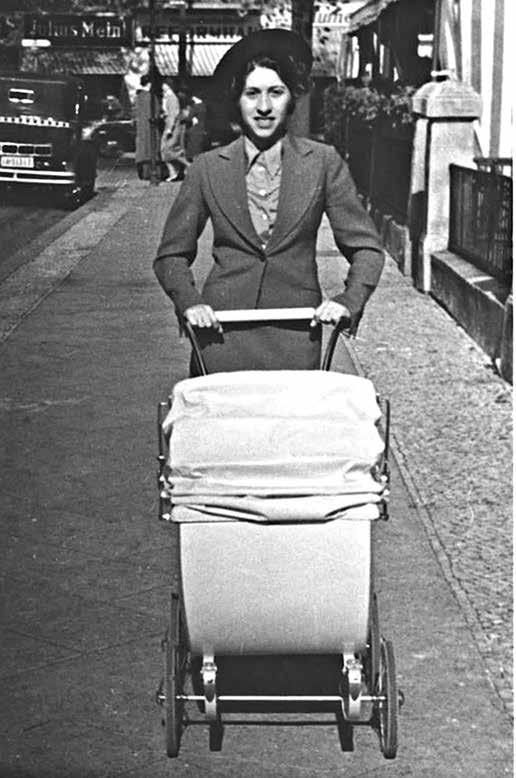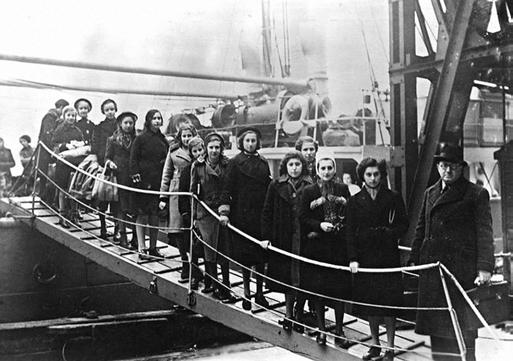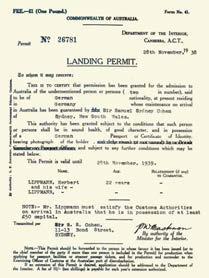
9 minute read
Failing to Understand Failure: Reassessing the Evian Conference of 1938
The Evian Conference took place in the resort town of Evian, France, between 6 and 15 July 1938. Formally named the ‘Intergovernmental Committee on Refugees from Germany (including Austria)’, it met at the invitation of US President Franklin D Roosevelt to discuss, in depth, the immigration policies of invited nations and their options for accepting refugees from Nazi Germany. The countries attending were not expected in any way to depart from their existing policies. When the meeting’s final recommendations were made no definite action was proposed – only that the deliberations should continue and a subsequent meeting should take place in London.
The major objective of this global conference was to do nothing. It was successful in achieving its fundamental aim of enabling an exchange of information among those attending, and nothing more. Contrary to what has become post-Holocaust popular wisdom, the delegates did not meet to open doors for refugee Jews, or force certain countries to ease their restrictions, or save Jews from the Holocaust. In 1938 there was, as yet, no Holocaust from which Jews needed saving.
Advertisement
There was, however, a refugee crisis and consequently, many nations were confronted with a situation that has many parallels with our own time.
Questions abounded: Should an opendoor policy be permitted for anyone claiming refugee status? Should quotas be imposed, and, if so, how are the decisions to be made as to numbers and eligibility? Should refugees be permitted entry on a short-term, long-term, or permanent basis? Should they be allowed in regardless of the prevailing economic situation? Should refugees of a different religious or ethnic background be given the opportunity to arrive? Should they be allowed to stay, thereby potentially transforming the existing social and/or ethnic fabric? The issues in 1938 (as today) were many, and the need to deal with them urgent.
An analysis of Roosevelt’s invitation reveals the following features: no particular ethnic, political or religious group should be identified with the refugee problem or the calling of the conference; nothing should be done to interfere with the operations of existing relief bodies; all assistance for refugee work should be drawn from purely voluntary sources; and no nation should be required to amend its current immigration laws to accommodate the refugees.
The agenda would be set by the US government, and the conference would be dominated by three men: Myron Taylor from the United States, Edward Turnour (6th Earl Winterton) from Britain and Henry Bérenger from France. During their presentations, each stated essentially that they were far from prepared to do anything that would expand Jewish refugee immigration to their countries. The United States said there would be no expansion, only a merging of the existing German and Austrian quotas; Britain said that there would be no discussion of Palestine or the colonial Empire; and the French stated that they had already taken enough ‘aliens’ and were ‘saturated’.
This gave a lead to all the other countries, as they too made their presentations. Analysing the addresses made by delegates it becomes apparent that often they did not have prepared instructions from their governments, and they made things up on the spot. They acted safe in the knowledge that they were interpreting faithfully their governments’ views. This was therefore a gathering of representatives who projected a comprehensive perspective of official reactions to the refugee crisis. It is not a pretty picture. Grouping them into blocs, we see several themes for each.
The Europeans were concerned about the possibility of supplanting the League of Nations High Commission for Refugees. They expressed a preference that the United States and other countries outside Europe should begin accepting a greater share of the burden. The European countries were only were only prepared to accept refugees for temporary asylum in a short-term transit capacity and, although there was much sympathy, no country could play an active role in facilitating refugee resettlement.
The Latin Americans, the largest group of states, were all keen to align with President Roosevelt’s call to link arms in a joint effort to ease refugee distress, and recognised that the refugee crisis was a humanitarian disaster. However, refugees would only be admitted in accordance with their existing laws; only those engaged in farming would be admitted; no special financial arrangements would be made to assist refugees; and any migration would have to proceed without any detriment to local workers. The Latin American states believed that the United States or the European nations should pick up the slack in solving the refugee issue. They also made it clear that urbandwelling professionals and intellectuals were not wanted.
The (self-governing) British dominions shared a sense of being able to take charge of their own affairs without interference from Britain, and stated that they had neither an interest in – nor a serious desire to help resolve – the refugee problem. Canada only wanted farmers; New Zealand did not want foreigners; Ireland, which had not originally been invited but went anyway, did not see itself as an immigrant-receiving country; South Africa did not attend; and Australia …?
Australia was represented by the Minister of Trade and Customs, Sir Thomas White, whose speech was largely the same as those of everyone else. He stated that ‘Australia has her own particular difficulties’. and that, were migration play any part in easing those difficulties, the only type that could be countenanced was British migration. Recognising ‘the unhappy plight’ of Jews in Germany and Austria, White explained that ‘they have been included on a pro rata basis, which we venture to think is comparable with that of any other country’. He added that, ‘Under the circumstances, Australia cannot do more, [and] as we have no real racial problems, we are not desirous of importing one by encouraging any scheme of large-scale foreign migration’.
As no nation could foresee the Holocaust, the sense of humanitarian urgency was less pressing than it would become in later years. And therein lies a major element embedded within any assessment of the refugee problem in Europe prior to the outbreak of war in September 1939: every country in the world was formulating and administering an immigration or refugee policy – not a rescue-from-the-Holocaust policy. No one holding senior office during the 1930s, in any major state (including Nazi Germany), envisaged the Holocaust that would emerge within 18 months of the outbreak of war. Thus, when it came to addressing the situation at Evian, the only concrete proposal was to keep on talking, while at the same time not compromising the direction in which governments had already been heading.
Historians cannot see around corners, and no truer claim can be made than that our long distant past was, once upon a time, someone else’s far distant future. This is the same trap into which historians and other commentators have since fallen when looking at Evian. The refrain ‘they should have foreseen what was coming’ just does not work.
That said, there were a number of areas in which the Evian Conference, when measured against the standards of 1938, was clearly deficient. Even if the Holocaust could not have been foreseen, the possibility of war was evident, but at Evian there was no discussion of what would happen to the Jews of Eastern Europe should Germany embark on a war of conquest and thereby increase the number of Jews under Nazi rule. The conference never managed to resolve the points of crossover between the League of Nations High Commission, other refugee bodies and the conference, and it failed to suggest any sort of financial arrangements for the refugees. Nor, shamefully, did the delegates even agree to condemn the Nazi antisemitic persecution that led to the refugee crisis in the first place; in a climate of high appeasement, that issue was not even raised. These were all within the conference’s remit as targets that could have been met, but none ever was.
One person, however, saw through the conference rhetoric. At an official level, no one else, it seems, was as insightful as Adolf Hitler, who assessed Evian better than anyone else at the time. The Nazis realised that the conference was focused more on looking good than on actually doing anything of a definite and lasting nature, and saw that it was about saving the reputation of attending countries rather than Jews. In a speech at the Nazi Party rally at Nuremberg on 12 September 1938, Hitler made explicit the connection between Roosevelt’s calling of the conference and his attempt to deflect attention away from an otherwise unhelpful American policy.
One final, key question needs to be asked: could the Evian Conference have made a difference to the events that were to follow? The best answer is only … perhaps. Evian could have acted as an occasion for caring administrations to voluntarily agree to increasing their refugee or immigration intakes. However, questions of realpolitik, racial and population preferences, antisemitism, economic priorities and other factors led to a collective rejection of any liberalisation in favour of Nazi Germany’s unwanted Jews. No other outcome was ever likely, and the hopes of many were consequently misplaced and unrealisable.
Therefore, is it legitimate to refer to Evian, as many have done in light of the Holocaust, as a ‘failed’ conference? I do not think so. After all, it lived up to the terms of Roosevelt’s original invitation and, as a result, delegates stated that their countries were actually doing quite a lot for refugees, while at the same time demonstrating that they could do no more and were not prepared to try. In what was a classic case of ‘virtue signalling’, the assembled countries used the opportunity to look good, but the refugees gained nothing.
It is perhaps no coincidence that the word Evian, when spelled backwards, reads ‘naive’, for that is precisely what the conference was. A cynical attempt to deflect attention from otherwise unhelpful policies on a global scale, for the Jews of Germany and Austria – and in the public consciousness ever since – the stakes for the Jews of Germany (and then Europe) were frighteningly high, confronting a regime that cared nothing for the standard conventions of international behavior and a community of states that cared little for the fate of the people they had come together to discuss. If there was any failure, it was a failure of imagination – both on the part of the countries attending and those hoping that some other outcome would be possible. Evian must be viewed through the lens of its initiation in March 1938, rather than the horrors of the Second World War and the Holocaust.
It is therefore heartbreaking that ever since Evian there has been a constant narrative that begins with the words ‘the failure of the Evian Conference’. Yet if its failure lay in the fact that the delegates did not foresee Auschwitz, they were not alone. No one in 1938 could have done so; more is the pity.
After Evian, but prior to the German attack on Poland precipitating the outbreak of war, many events further reduced options for the Jews of Germany. These included the establishment of a Nazi Office of Jewish Emigration to speed up the pace of Jewish emigration from Germany (1 August 1938); the requirement that Jewish women add ‘Sarah’ and men add ‘Israel’ to their names on all legal documents (17 August); the closure of Swiss borders for Austrian Jews seeking sanctuary (19 August); the Munich Agreement in which Britain and France surrendered the Sudetenland regions of Czechoslovakia to Germany by negotiation (29–30 September); the compulsory stamping of passports belonging to German Jews with the letter ‘J’ to indicate their identity (5 October); the Kristallnacht pogrom throughout Germany and Austria (9–10 November); the German invasion of what remained of Czechoslovakia (15 March); and the return to Europe of the SS St Louis , a ship carrying 936 Jewish passengers, after being denied entry into Cuba and the United States (17 June). Germany invaded Poland on 1 September 1939; Britain and France declared war on Germany two days later.
While it is true that before Evian there were no mass deportations or large-scale brutal assaults against Jews, it is equally true that these began in increasing measure after Evian. Were these in response to the nations of the world turning their back on the Jews in July 1938? Ascribing too much to a Nazi grand plan leading to the Holocaust is dangerous; as stated earlier, no
Arrival of Polish Jewish refugees in London, February 1939

Australian landing permit for Herbert and Ilse Lippman dated 28 November 1938 one at Evian could anticipate what would happen next, and Nazi policies did not foresee the events to follow. There could be no escaping the fact, however, that even in July 1938 the Jews of Germany were in desperate straits, or that the states represented at Evian displayed little other than apathy and disregard over their ultimate destiny.

The years following Evian should have broadened humanity’s horizons. How far that rings true today is for another generation to judge, but considering Evian they will have a template upon which to rest their considerations.
Two quotes exemplify the relevance of the Evian Conference for the present: Rabbi Hugo Gryn, a Holocaust survivor who became one of the leading spiritual leaders in the United Kingdom wrote in his memoir, ‘Time is short and the task is urgent. Evil is real. So is good. There is a choice.’ And Elie Wiesel stated, ‘The opposite of love is not hate, it’s indifference. The opposite of beauty is not ugliness, it’s indifference. The opposite of faith is not heresy, it’s indifference. And the opposite of life is not death, but indifference between life and death.’
This is an edited version of a public lecture presented by Professor Paul R Bartrop at the Jewish Holocaust Centre (JHC). Professor Bartrop is Professor of History and Director of the Center for Judaic, Holocaust and Genocide Studies at Florida Gulf Coast University, Fort Myers, Florida, United States. He is currently a Visiting Fellow at the JHC.





